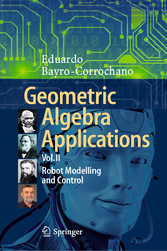Suchen und Finden
Service

Geometric Algebra Applications Vol. II - Robot Modelling and Control
Eduardo Bayro-Corrochano
Verlag Springer-Verlag, 2020
ISBN 9783030349783 , 600 Seiten
Format PDF
Kopierschutz Wasserzeichen
Geräte
This book presents a unified mathematical treatment of diverse problems in the
general domain of robotics and associated fields using Clifford or geometric alge-
bra. By addressing a wide spectrum of problems in a common language, it offers
both fresh insights and new solutions that are useful to scientists and engineers
working in areas related with robotics.
It introduces non-specialists to Clifford and geometric algebra, and provides ex-
amples to help readers learn how to compute using geometric entities and geomet-
ric formulations. It also includes an in-depth study of applications of Lie group
theory, Lie algebra, spinors and versors and the algebra of incidence using the
universal geometric algebra generated by reciprocal null cones.
Featuring a detailed study of kinematics, differential kinematics and dynamics
using geometric algebra, the book also develops Euler Lagrange and Hamiltoni-
ans equations for dynamics using conformal geometric algebra, and the recursive
Newton-Euler using screw theory in the motor algebra framework. Further, it
comprehensively explores robot modeling and nonlinear controllers, and discusses
several applications in computer vision, graphics, neurocomputing, quantum com-
puting, robotics and control engineering using the geometric algebra framework.
The book also includes over 200 exercises and tips for the development of future
computer software packages for extensive calculations in geometric algebra, and a
entire section focusing on how to write the subroutines in C++, Matlab and Maple
to carry out efficient geometric computations in the geometric algebra framework.
Lastly, it shows how program code can be optimized for real-time computations.
An essential resource for applied physicists, computer scientists, AI researchers,
roboticists and mechanical and electrical engineers, the book clarifies and demon-
strates the importance of geometric computing for building autonomous systems
to advance cognitive systems research.
Shop


